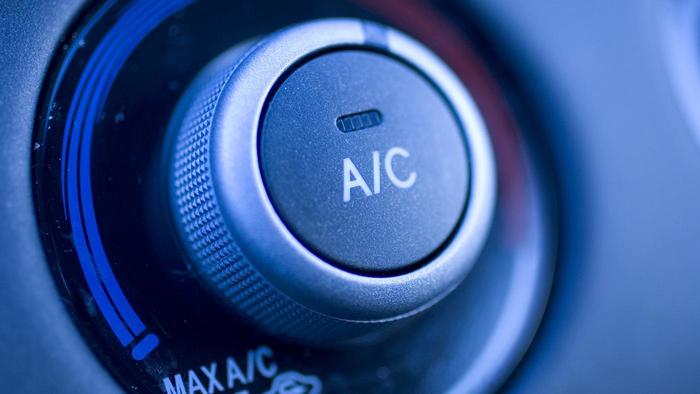While a functioning air conditioner isn’t required to make your vehicle run, it sure makes it more comfortable. This system requires routine maintenance, just like the other parts of your engine, including keeping it lubricated so it can run properly. One way to perform this service yourself is with an AC oil injector. In this article, we talk about the AC system in general, what an oil injector is, and what it can do to help keep you cool while driving.
It is easy to take for granted the air conditioning in a car or truck when we get inside on a hot day. Life would be a lot less pleasant if it required riding around in a hot vehicle, sweating beneath the seat belt and sticking to the seats.
We simply expect the car AC system to begin cooling immediately after we fire it up. Until it doesn’t. When hot air blows out of the air conditioning vents, it can make the day very uncomfortable, not to mention expensive.
Air conditioning systems, whether inside a house or a car, are complicated machinery that work on some simple principles. The primary principle is this: when gas expands, it cools; when it is compressed, it heats up. (The reverse occurs as well: as gas cools, it contracts; when it heats up it expands.)
This principle is at work in a hot air balloon. Propane at the base of the balloon is heated, causing it to expand. Because heated gas is lighter than atmospheric air, the balloon rises. When the heat is turned down, the gas in the balloon contracts, causing it to become heavier and (thankfully) return to Earth.
Another way to see this is to grab a can of compressed air, like the spray used to blow dust off computer keyboards. The can may feel room temperature at first, but as air is sprayed out the nozzle, the air inside the can expands and cools. You can feel it go cold in your hand. If you have ever wondered why that happens, thank the Joule-Thompson effect, which is the name given to the science behind gas heating and cooling when contracting and expanding.
How the Compressor Works in an AC System
In an automobile air conditioning system, liquid refrigerant with a low boiling point – that is, it enters a gaseous state at relatively low temperatures – is squeezed, heated and turned into gas in the compressor. The compressor is the one moving part in the car AC system. As a result, it is the most prone to malfunctioning and the one part of the system that requires oil to keep it lubricated. Without a working compressor, the air conditioning system ceases to do its job.
The compressor is the first leg of the refrigerant’s journey through the system to cool the cabin and make life inside for the driver and passengers more comfortable. The compressor is connected by belts to the crankshaft, which pumps up and down, turning the belts and powering the compressor. Compressing liquid refrigerant causes its temperature to rise and transform into a gas. The compressor next pumps the hot refrigerant gas to the condenser.
The condenser looks like a junior radiator and performs the same function. As the heated and pressurized refrigerant passes through the condenser coils, a fan blows the heat into the atmosphere, cooling down the refrigerant and transforming it back into a liquid. That cool liquid will ultimately cool the inside of the cabin. But we are not there yet.
The cool, liquid refrigerant must first get cleaned up before it enters the evaporator. It passes through the dryer, which contains cleaning particles that attract water and remove it from the refrigerant. This is important because the refrigerant may fall below the freezing point for water, and ice would prevent the flow of refrigerant.
The crystals in the dryer, also known as desiccants, are very much like the package you might find in a shoebox to keep moisture from ruining new shoes.
From there, the cold liquid flows through an expansion valve or orifice tube, each of which regulates the flow of refrigerant while cooling it further. Then it is on to the evaporator, located right at the base of the passenger compartment. There, it navigates a maze of coiled pipes, absorbing heat from the hot compartment with help from a blower that pushes the cool air around the pipes into the cabin.
As the heat transfer occurs from cabin to refrigerant, the liquid turns back to gas and moves on to the compressor to begin its adventure all over again. Pity the poor compressor: it’s work is never done. The refrigerant just keeps cycling through the system, heating and cooling, changing state between liquid and gas repeatedly, as long as the air conditioning is on. Like a school teacher, the compressor works relentlessly in a critical role until the season is over and can then take a couple of months off – in the compressor’s case, during the winter.
The AC Oil Injector
Most drivers know the single most important thing they can do to maintain the good health of their vehicle is to change the oil regularly to keep the moving parts of the engine clean and lubricated.
Air conditioning systems also require oil to keep the mechanical parts of the compressor operating smoothly. Cycling the AC compressor on and off, and punishing it with high pressure and wide temperature gradients adds wear and tear. The compressor also lives in an environment that is constantly vibrating and sustaining impacts from the engine running and the car driving down bumpy roads. This is a difficult life for any pump or compressor, so it is important to take care of the AC compressor.
Most automotive manufacturers recommend changing the compressor oil every time the refrigerant needs to be replaced. The Red Angel Oil Injector, a durable, all-metal, two-ounce canister, is designed to inject a leak repair solution, oil, or UV dye into the AC system through the vacuum pump. It comes with connection hoses, a tap for the refrigerant can, and quick coupler for use in any R-134a system.
The injector can be connected to the vacuum hose to pull its contents after the system is evacuated. During evacuation, air and moisture that inevitably infiltrate when the system is opened are removed.
Evacuation involves connecting a vacuum pump to both low- and high-pressure sides for about 30-45 minutes. The vacuum must draw 500 microns or 29.92 hg of pressure to remove moisture and non-condensable gas from the system. During evacuation, it is generally recommended that the receiver/dryer also be replaced, to be sure that all the moisture is removed.
This device can also be used to push its contents into the system during recharge.
The Red Angel Oil Injector can be used to add Red Angel A/C Stop Leak, which is activated by a difference in temperature within the system, caused by a leak point needing repair. Red Angel will not harden or crystallize with any existing moisture in the system and is non-clogging. Once the leak is sealed, Red Angel sealant will stay in the system and continue to condition and lubricate for optimal performance.
Follow these steps to add oil or refrigerant using the oil injector:
- Turn on the air conditioner and make sure the compressor is running.
- Unscrew the cylinder, add the oil, refrigerant, or dye, and connect it tightly to the oil injector.
- Connect the R-134a coupler to the injector and the other end of the injector to the low-side service port.
- Open the valve on the injector to allow the product to enter the AC system.
- If adding refrigerant, consult the owner’s manual to determine the proper pressure and fill to that pressure.
Keeping your AC unit maintained will ensure it continues to keep you comfortable while driving, and having the proper tools to do the job, like an oil injector, can make the required maintenance easier.
BlueDevil Products can be found at AutoZone, Advance Auto Parts, O’Reilly Auto Parts, NAPA, Parts Authority, Auto Value, Bumper to Bumper and other major auto parts retailers.
BlueDevil Products can be found on Amazon.com or at AutoZone, Advance Auto Parts, O’Reilly Auto Parts, NAPA, and other major auto parts retailers.
Related Articles
Search Blog
Subscribe
Blog Categories



